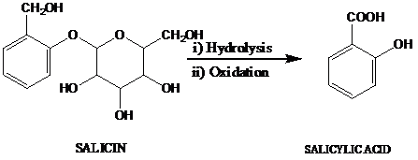Aspirin: Drug Stories Part-II
Aspirin
The chemical name of aspirin is
acetyl salicylic acid. Introduced into therapeutics in 1897, it has
successfully completed 125 years and still holds the scientists and doctors in
awe over it's possible uses! We will get to these uses later. First, about the
discovery…
There are accounts of usage of bark of willow tree (Salix sp.) by many old civilisations like Assyrians, Sumerians, Egyptians and Chinese for treatment of conditions like muscular and joint pain, rheumatism and fever.
However, the first modern report about systematic experimentation on the therapeutic action of willow bark in treatment of ‘ague’ (a fever marked by paroxysms of chills, fever, and sweating that recur at regular intervals) conducted by Edward stone, a vicar in Chipping Norton, Oxfordshire was published by the Royal Society in 1763. Reverend Edward had accidentally tasted willow bark and its bitterness reminded him of chinchona bark (contains quinine) that was then being used to treat malaria. He believed in the 'doctrine of signature' which dictated that the cures for the diseases would be found in the same location where malady occurs. Since the willow favours a moist and wet soil, where agues is also more prevalent, he gathered a pound of willow bark, dried it in a baker’s oven for 3 months, pulverized and administered it to 50 patients with safety and success. However this process was quite tedious restricting its popularity.
Progress made by
science and technology in the 19th century helped scientists to
isolate and characterize compounds from herbal extracts. A major breakthrough was
achieved in 1826 when a scientist called Henri Leroux isolated a compound that
was later called “salicin (named after the name of the willow tree, Salix)”
from willow bark. Two years later, in 1828 a German professor, Joseph Buchner also
reported isolation of salicin, a yellow, bitter tasting compound.
With further progress in chemistry, an Italian scientist named Raffaele Piria in 1838 was successful in elucidation of structure of salicin. He described salicin as a beta-D-glucoside that is hydrolysed to salicyl alcohol and glucose. He further oxidised salicyl alcohol to salicylic acid.
In 1876, a physician, Thomas
Maclagan, used salicin to treat patients who had rheumatism, and he reported
its beneficial effects in The Lancet. He can be credited with conducting the first
rigorous trial of salicin. Maclagan reportedly tried the willow bark
powder on himself before giving it to patients to treat rheumatism (any disease marked by
inflammation and pain in the joints, muscles, or fibrous tissue, especially
rheumatoid arthritis). This trial played an important
role in establishing the fact that salicin had a definite action on rheumatism.
Subsequently salicylic acid was established to be having the same therapeutic
effects as that of salicin. Kolbe's
efforts had already opened the doors for large scale synthesis and thus the
tedious process of extraction of salicin from willow bark and its conversion to
salicylic acid was abandoned. Salicylic acid though found to be an effective
analgesic and inflammatory agent, it's bitter taste and severe gastric
irritation was hindering its long term use.
As was the norm those days, several derivatives of salicylic acid were synthesized including salts and esters. Bayer, a company engaged with manufacturing of dyes, by 1882 had begun to appreciate and capitalize on the pharmacologic properties of some of the by-products obtained in its dye manufacturing process. Many ester derivatives too were synthesized. Felix Hoffmann possibly under the direction of colleague Arthur Eichengrün (there is a controversy regarding who discovered it first!) in the year 1897 synthesized acetyl salicylic acid by acetylating the hydroxyl group of salicylic acid. This compound too was tested for analgesic action and proved to be very effective. Notably, it was observed to have much less gastric irritation than salicylic acid.
The process was subsequently patented by Bayer who
named acetylsalicylic acid as aspirin. In the name the letter ‘A’ stands for acetyl, “spir” is derived from the plant known as
Spiraea ulmaria (meadowsweet), which
yields salicin, and “in” was a common
suffix used for drugs at the time of the first stable synthesis of
acetylsalicylic acid. In 1898 Bayer started to market aspirin tablets that made
the use of aspirin popular as an analgesic and inflammatory agent.
Even after more than 125 years and discovery of many
drugs having similar pharmacological action, aspirin still is going strong and
remains popular with the doctors not only as an analgesic but also as a
preventive for thrombosis due to its inhibitory action on platelet aggregation
(DOI: 10.2500/108854186779045539). Recently reports are emerging about aspirin’s
possible use in treatment of certain types of cancers.
While low dose (75mg) of aspirin is reported to help
prevent heart attacks, high doses (300mg) are required for pain management.
Aspirin is sold under several brand names in India
such as Ecosprin, Sprin, Aspro, Eprin and Delisprin to name a few. A well known
side effect of chronic administration of high doses of aspirin is
gastrointestinal bleeding and ulceration. Formulation scientists have been able
to counter this problem to some extent by using buffered tablets (Disprin).
This product is a combination of aspirin and an antacid (such as calcium
carbonate, aluminum hydroxide, or magnesium oxide). The antacid helps reduce
hyperacidity associated with aspirin.
Aspirin has been combined with many other drugs for
ease of administration. Some of the examples are:
Caffeine, clopidogrel, codeine, dipyridamole, atorvastatin,
isosorbide mononitrate, paracetamol, citric acid, ethoheptazine and ramipril.





Thankyou mam! For such Great Information..We would like to know about more such compounds.
ReplyDeletevery useful and interesting information
ReplyDeleteThank you..amazing
ReplyDelete